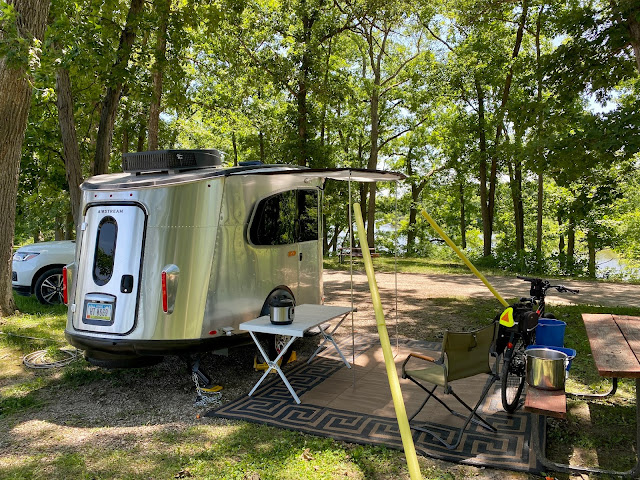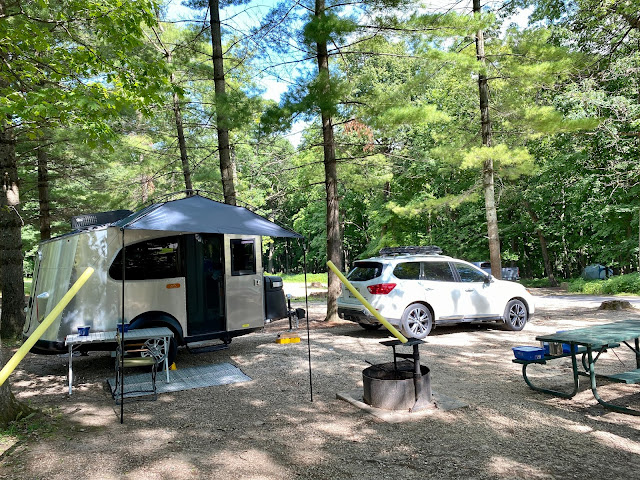 |
| The town of Anamosa, right next to Wapsipinicon State Park |
Wapsipinicon State Park in Iowa is an enigma. I left after four nights at the park with more questions than answers. Did I enjoy my stay? Yes! Did I not enjoy my stay? Well, also yes, in some ways. Will I go back again sometime? "Maybe" is the most honest answer I can give. Let me explain . . .
 |
| Wapsi campsite, electric hook-up but no water |
Having only about twenty-five campsites, the Wapsipinicon campground is fairly small. Thirteen of the sites have electric. (I used 30 amp with my Airstream Basecamp, but I don't remember if there was 50 amp available.) Drinking water is available at a spigot over near the restroom/shower house. The sites are not particularly level, although I was able to level up my site easily. The modern toilet/shower facility is probably the oldest and smallest I've seen in all the state parks I've visited.
 |
| My neighbor for two nights |
And that's the oddity about Wapsipinicon State Park--it's the oldest, funkiest Iowa state park I've camped at in the state. It's older and more worn than even quite a few county parks, which is saying a lot because there is quite a range of quality in county parks. The other half of the oddity is that Wapsi is also a beautiful park. The Wapsipinicon River edges the lower part of the park, and Dutch Creek passes through the park; there are hiking trails and some beautiful wooded areas; a long, circular driving road circumscribes the park; the campground, even though a 1.0 version, is still clean; and because the park edges the city of Anamosa, facilities are close. The easiest way to describe the ups and downs of Wapsi is to describe the variety of activities I engaged in because that's probably the biggest draw for this state park--there are a lot of different things to do because of the river, the park layout, and the nearby town.
The campground is located on a ridge above the river, so flooding isn't an issue. I found that the campground itself, although clean and administered by a host who lived in a home-built tiny home on a trailer, wasn't a place I felt satisfied just sitting beneath my awning and enjoying the ambiance. The campground adjoins to the local golf course, and the country club is nearby--far enough away to not intrude but still visible with traffic skirting one edge of the campground. The main park really reminds me of the second-largest city park in the U.S., Bidwell Park in Chico, California. Both are large parks with a variety of day use and picnic facilities that include a variety of terrain. Wapsipinicon is smaller but there is still a driving route through the park with hiking, picnicking, site-seeing, and fishing spots along the way. Even though I don't kayak (yet), I could see that kayaking the Wapsipinicon is a popular activity. The campground is really a launching base for a variety of activities.
 |
| The ford is a popular spot on the park's loop drive. |
 |
| A view of the river from the Lower Park Road |
 |
| A view of the river from historic Hale Bridge, now a walking bridge |
My initial explorations were short hikes from camp. They all include a steep walk down to water level and then, of course, a steep walk back up to camp! Walking trails and a couple of caves are included in within walking distance down the hill. The next day I put my folding
Montague Allston bicycle together and had much more fun. I sailed down the hill, crossed a stone bridge, by-passed the stream-fording feature for cars (the upside-down bridge), crossed a walking bridge, and biked a section of the Wapsi Trail that was paved into town to buy a few veggies at the Farmers' Market. The next day I biked and explored more and if I'd stayed longer, I would have spent more time exploring bicycling opportunities. The Wapsi Trail, I believe, is a longer trail, but I could only find a short 1-2 mile paved section.
 |
| Downtown Anamosa, Iowa |
Downtown Anamosa, from what I saw, is a mixture of remodeling and closed stores, not too different from many small towns in Iowa. There were several interesting restaurants and a grocery store downtown. At the edge of the community, bordering the freeway, there is a Walmart. I would have enjoyed more time exploring, although I have to tell you that because this is a river town, there is quite a bit of up and down riding which included some getting off and pushing the bike for me. I feel the town is hard at work trying to make downtown a nice place to visit.
 |
| Across the bridge is the park's main entrance |
One pull that this state park has for me is that the cellphone strength is pretty good. That would allow my wife to camp with me and still be able to work online. It would also be easy for longer stays because the town close-by provides opportunities for buying provisions--and the restaurants could provide a chance to buy some take-out for a special meal every now and then. I think the park, being so close to town, is in many ways another example of urban camping; however, since Anamosa isn't really "urban," there is still some sense of the rustic. Bicycling for me was a real draw, too; the town and area is small enough that riding was not too intense on the roads, and the rural roads mostly had gravel edges rather than drop-offs.
Will I camp again at Wapsipinicon State Park? Probably . . . sometime. The issue for me is that I have a pretty big choice of closer campgrounds that are just as nice. Variety is good, though, and I think this especially would be a beautiful state park in the fall . . . but aren't they all? Ah, decisions, decisions.












































